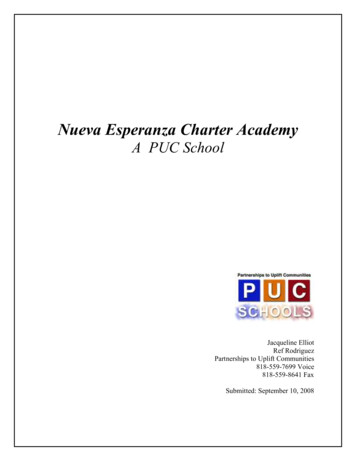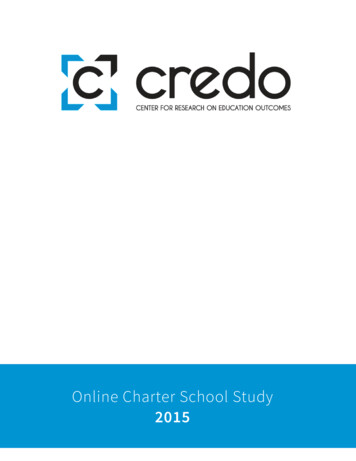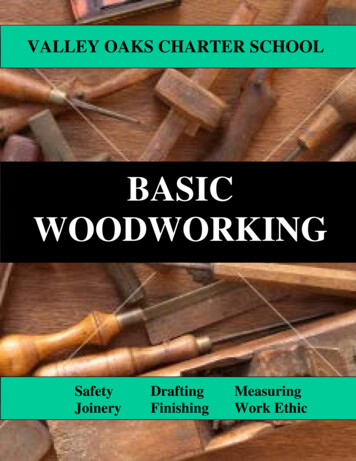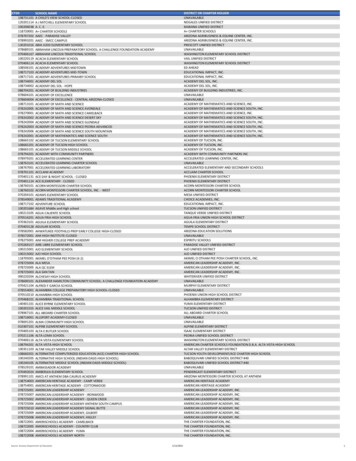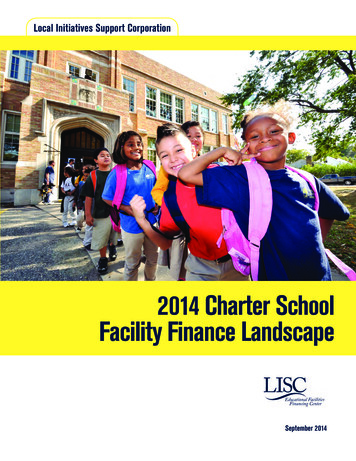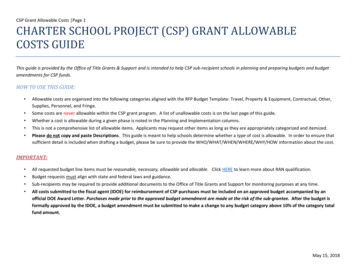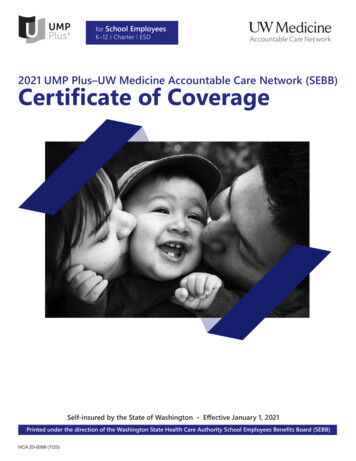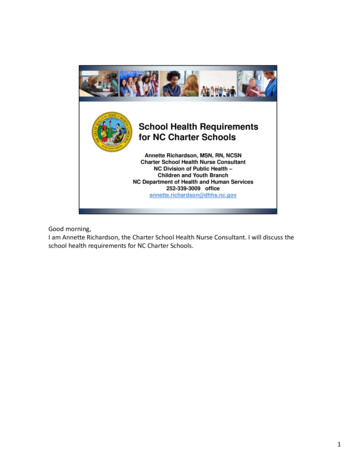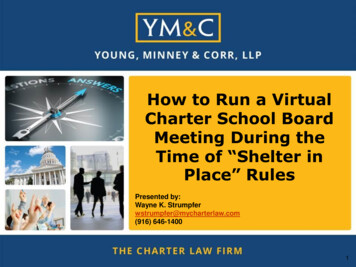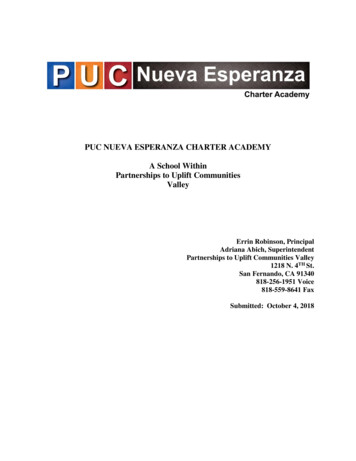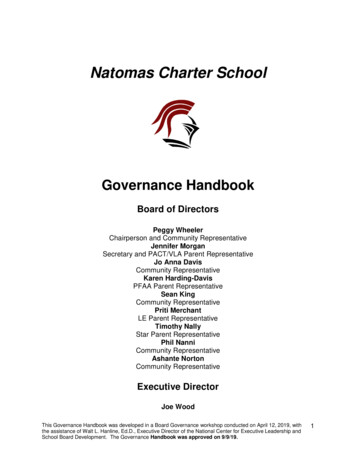
Transcription
Natomas Charter SchoolGovernance HandbookBoard of DirectorsPeggy WheelerChairperson and Community RepresentativeJennifer MorganSecretary and PACT/VLA Parent RepresentativeJo Anna DavisCommunity RepresentativeKaren Harding-DavisPFAA Parent RepresentativeSean KingCommunity RepresentativePriti MerchantLE Parent RepresentativeTimothy NallyStar Parent RepresentativePhil NanniCommunity RepresentativeAshante NortonCommunity RepresentativeExecutive DirectorJoe WoodThis Governance Handbook was developed in a Board Governance workshop conducted on April 12, 2019, withthe assistance of Walt L. Hanline, Ed.D., Executive Director of the National Center for Executive Leadership andSchool Board Development. The Governance Handbook was approved on 9/9/19.1
Building a Governance TeamThe Board and Executive Director are committed to work together as a governanceteam. For a Governance Team to work together effectively, members need to maintaina unity of purpose, agree on and govern within appropriate roles, create and sustain apositive governance culture, and create a supportive structure for effective governance.What do we stand for? Our shared purpose is to have the best learning environment for all students. We want to build trust and move the Charter forward. We want to perpetuate a legacy of positive culture as people come and go. We want to understand our individual jobs and collective responsibilities. We want to be partners with the staff in positive change. We want to oversee the putting together of a first-rate program, making sure wecontinue to improve – never resting on our laurels.Governance NormsIn addition to meeting the norms below in order to create a positive culture andatmosphere, WE AGREE TO: To show respect (never dismiss/devalue others). Make a commitment to open communication, honesty, no surprises. Be collaborative (this is the way we operate). Maintain confidentiality (builds trust). Look upon history as lessons learned; focus on the present and the future. Commit the time necessary to govern effectively. This means being there ontime, being knowledgeable, participating, understanding the full scope of being aBoard Member and being willing to take on all the responsibilities involved.AND – ABOVE ALL – Focus on students’ best interest – on what’s best for the students. This is whatwe do. And it is the touchstone that allows us to have our differences.This Governance Handbook was developed in a Board Governance workshop conducted on April 12, 2019, withthe assistance of Walt L. Hanline, Ed.D., Executive Director of the National Center for Executive Leadership andSchool Board Development. The Governance Handbook was approved on 9/9/19.2
Roles and ResponsibilitiesThe role of the Directors is to stay focused on the big picture while fulfilling fiveresponsibilities in a series of job areas. These five responsibilities are:1. We set the direction.2. We establish the structure.3. We provide support.4. We ensure accountability.5. We act as Charter leaders.We carry out these responsibilities in each of the following job areas: Setting the School’s Direction Student Learning and Achievement Student Safety and School Culture Finance Facilities Human Resources Policy Judicial Review Community Relations and AdvocacyThe Executive Director assists the Board in carrying out its responsibilities in each ofthe job areas, in additional to leading the staff toward the accomplishment of the agreedupon vision and goals.This Governance Handbook was developed in a Board Governance workshop conducted on April 12, 2019, withthe assistance of Walt L. Hanline, Ed.D., Executive Director of the National Center for Executive Leadership andSchool Board Development. The Governance Handbook was approved on 9/9/19.3
Board Governance ProtocolsLeadership Responsibility and Roles of the BoardBoard members carry authority only as Board, not as individuals. Individuals can requestaction by bringing up a new idea, explaining their interest in a particular course ofaction and working to get a Board majority to support moving in that direction. When amajority of the Board, sitting in a formal meeting, requests action, that request shouldbe made in the context of the intended results (what is to be accomplished), not themethods used to achieve those results.In order to be effective representatives of the Board and Charter, members will: Behave at all times in a manner that reflects positively on the Charter. Refrain from obligating the Board and/or administration by actual speechor implication, unless authorized to do so by the Board. Represent the Board, as a Board member, minimally, at 2 events each yearoutside the Board member’s child’s academy. Refer any concerns, questions, or comments to the Executive Director asspecified in the protocol on Responding to Concerns. Reinforce with the community the key messages agreed upon by theBoard.In responding to concerns regarding the work of the Charter, Board members will: Receive the information, remembering that only one side of the story isbeing presented (listening). Repeat the information – paraphrase to ensure understanding. Remind the individual that a Board member has no authority as anindividual and share the appropriate line of command and process tofollow to address their concern. Re-Direct – Thank them for sharing their thoughts and refer them to theappropriate staff member and, if necessary, inform them of the formalcomplaint process. Report – In a timely manner, inform the Executive Director.This Governance Handbook was developed in a Board Governance workshop conducted on April 12, 2019, withthe assistance of Walt L. Hanline, Ed.D., Executive Director of the National Center for Executive Leadership andSchool Board Development. The Governance Handbook was approved on 9/9/19.4
Leadership Responsibility and Roles of the Board (continued)When interacting with the public and their constituents, Board members will hold to thehighest level of professional and ethical conduct, including emphasizing the positiveaspects of the Charter.Board members, in the work of the Charter, shall support the Executive Director increating and strengthening connections between community members and the Charter.The Board’s Role and Relationship with the Staff and CommunityWhen individually visiting Academies or Departments, as a professional courtesy, Boardmembers are encouraged to notify the Executive Director that they will be visiting anAcademy or Department and may provide input to the Executive Director on issues orconcerns that may arise from such a visit.At no time, while visiting Academies shall a member make promises, either overt orimplied, interfere with administration, or involve him or herself in personnel issues, orstudent records.To assist in this matter, the Executive Director will ensure that teachers know that ateacher does not need to interrupt his/her lesson when a visitor is in his/her classroom.When specific requests from Board members are directed to staff members, staffmembers are directed to relay such requests to their supervisor to ensure thatappropriate information is provided to all Board members.Management staff are directed to relay requests from Board members to the ExecutiveDirector to ensure that appropriate information is provided to all Board members.This Governance Handbook was developed in a Board Governance workshop conducted on April 12, 2019, withthe assistance of Walt L. Hanline, Ed.D., Executive Director of the National Center for Executive Leadership andSchool Board Development. The Governance Handbook was approved on 9/9/19.5
Board Meetings and the AgendaMeetings of the Board are held in public but are not open-forum town hall meetings.Meetings will be conducted in such a way as to allow the public to provide input in thetime allotted to ensure that multiple voices of the community inform Boarddeliberations; however, when the Board deliberates, it will be a time for the Directorsto listen and learn from each other, taking public input into consideration without reengaging the public.Board meetings will normally be on the Second Monday of each month. Each Boardmeeting will begin. The Regular Public Meeting will begin at 5:30 pm with ClosedSession to follow. Study Sessions may be scheduled and shall be scheduled at thediscretion of the Board.The Executive Director, with the support of staff, will create each Board Agenda. Inadvance of the preparation of the Board Agenda, Board members may request items tobe placed on the agenda. The Board Chair and the Executive Director will discuss thecontents of the agenda and the process that will be followed at the meeting, in advanceof the Board Meeting.The Executive Director and Board believe that the need for information and/orclarification on agenda items is best accomplished by the submission of writtenquestions/requests for such ahead of meetings. This will allow for in-depthconsideration of items without unduly lengthening the meeting time.Board members will make every effort to submit, prior to the meeting, questions theyintend to ask so that the Executive Director and Charter staff has the opportunity toprepare to answer Board members’ questions at Board meetings.When an individual Board member requests information, that information will beprovided to all Board members. If unforeseen questions arrive during the meeting,Directors will acknowledge their question or comment as spontaneous and that theyunderstand that staff may not have the information on hand to answer the question.This Governance Handbook was developed in a Board Governance workshop conducted on April 12, 2019, withthe assistance of Walt L. Hanline, Ed.D., Executive Director of the National Center for Executive Leadership andSchool Board Development. The Governance Handbook was approved on 9/9/19.6
Board Meetings and the Agenda (continued)Individual Board members are expected to self-monitor compliance to Public Meetinglaws (Brown Act), including limiting Closed Session to the legally appropriate agendaitem(s).Board members need equal access to information, and to operate within theboundaries established within the Public Meeting laws.The use of email and social communication is subject to the Public Meeting Law. TheExecutive Director shall forward questions and answers to all Board members. Boardmembers, when responding, may not “reply to all.”The Board wishes to maintain a culture of professionalism, stay focused, and respectthe need of Directors to be available to their families: Cell phones will be set for ‘silent’ or vibrate. Directors will be discreet in checking cell phones if necessary.Board members individually and collectively demonstrate confidentiality as appropriateand as outlined through the mandates of the California Education Code, the Brown Act,and other compliance criteria established by law or legislation. Respecting theconfidentiality of information maintains the Board’s judicial review role.Board members will review the information provided to them and be open to ongoingprofessional development and training.Each Board member respects the right of other Board member to vote in the minorityposition. If so doing, each Board member agrees, as a courtesy to the team, to explainthe reason for their minority vote, either during deliberation or after casting the vote.This Governance Handbook was developed in a Board Governance workshop conducted on April 12, 2019, withthe assistance of Walt L. Hanline, Ed.D., Executive Director of the National Center for Executive Leadership andSchool Board Development. The Governance Handbook was approved on 9/9/19.7
Board Meetings and the Agenda (continued)The Board believes that it best serves the Charter that Board members vote on eachitem on the agenda.Whenever abstentions are considered, abstentions are most appropriate in cases wherethere is a personal relationship between a litigant and a member (perception of bias), adecision that financially impacts the member or his or her immediate family (legalconflict), or a personal connection to the member that may bias a decision on discipline.When abstaining because there may be a perception of bias, the member is encouragedto so state.Where an actual legal conflict of interest exists, the member must publicly declare theconflict and recuse him or herself from voting at all.When a member abstains, his/her abstention shall not be counted for purposes ofdetermining whether a majority of the membership of the Board has taken actionBoard members will model professional behavior by being polite and respectful of thepoints of view held by their fellow Governance Team members.Governance Team members are reminded that policy and decisions reserved to theBoard must be made as a Board. Once the decision has been made, it becomes thedecision of “the Board.”Under the concept of majority rule, each member is compelled to support thesuccessful implementation of a policy decision, program, or procedure even when he orshe does not agree with the decision.If a member of the Governance Team cannot support the decision of the Board becauseit offends a moral/personal code, the member is expected, at a minimum, to refrainfrom undermining the decision or directive.This Governance Handbook was developed in a Board Governance workshop conducted on April 12, 2019, withthe assistance of Walt L. Hanline, Ed.D., Executive Director of the National Center for Executive Leadership andSchool Board Development. The Governance Handbook was approved on 9/9/19.8
Board Meetings and the Agenda (continued)The Governance Team will strive for brevity in deliberations, keeping remarks brief andto the point so that all opinions can be expressed and meetings can be efficient.Addressing each agenda item the Board shall, normally, adhere to the followingprocess: Input from the Community Staff Presentation/addressing questions from the Board(Staff members, when presenting items to the Board, are to provide appropriate back-upmaterial for the Board to review prior to the Board meeting. If it is necessary to provide apresentation to the Board, presentations are to be limited to not more than 15 minutes, unlessprior approval of the Chair is received.) Board Discussion and DeliberationThe Governance Team will follow the following steps for a policy revision process:1. School receives suggested policy updates from legal counsel.2. Administrative team reviews policy language and develops a suggested policy forthe Executive Director and Board to review.3. Policies presented to the Board will be added to the Action Section of the agenda.Public ParticipationSince the Public Meeting Law (Brown Act) expressly prohibits discussion leading toaction from being conducted unless agendized, Governance Team members arestrongly encouraged to refrain from engaging members of the public in dialogue aboutissues not on the agenda.As a result of a comment under public communication, a member may ask theExecutive Director to briefly comment for clarity or correction. The member may alsoask that a matter be investigated, with or without a follow-up report to the Board.If a Governance Team member feels compelled to speak to the issue, the member mustfirst be recognized by the Board Chair. The comments must be brief and only clarifyingor correcting. Any further discussion should be agendized.This Governance Handbook was developed in a Board Governance workshop conducted on April 12, 2019, withthe assistance of Walt L. Hanline, Ed.D., Executive Director of the National Center for Executive Leadership andSchool Board Development. The Governance Handbook was approved on 9/9/19.9
The Board’s Relationship with the SuperintendentThe Board will commit to work through and with the Executive Director on issuesregarding the running of the Charter. The Executive Director will inform the Board assoon as possible of: serious safety concerns serious disciplinary action serious / unexpected personnel changes or disciplinary issues serious illness or death of a student, staff or Board member legal or liability concerns notable achievementsIn all matters, the Board and Executive Director are expected to protect confidentialinformation.It is the Executive Director’s responsibility to organize the staff in the manner that bestserves the needs of the Charter. As a professional courtesy, the Executive Director shallprovide appropriate notice to the Board in advance of action being taken.As the norm, the Executive Director speaks on behalf of the Board. The Board Chair isauthorized to speak on behalf of the Board, when necessary.The Executive Director will inform the Board when media contacts the ExecutiveDirector.All conflicts between the Executive Director and the Board will be handled in ClosedSession, with the Executive Director being in attendance, when appropriate andnecessary.Conflicts between individual Board members and/or the Executive Director will beaddressed privately between those who hold the conflict and will not involve othermembers of the Board or the public (community, staff, media etc.).This Governance Handbook was developed in a Board Governance workshop conducted on April 12, 2019, withthe assistance of Walt L. Hanline, Ed.D., Executive Director of the National Center for Executive Leadership andSchool Board Development. The Governance Handbook was approved on 9/9/19.10
The Board’s Relationship with the Superintendent (continued)The Board commits to complete an annual evaluation of the Executive Director. TheBoard will set aside at least one special meeting for the purpose of completing theannual evaluation of the Executive Director.In consultation with the Executive Director, the evaluation process and associateddocuments will be developed and approved by the Board, not later than October 31steach year. The evaluation process and instrument are designed to bring about thecollective view of the Board. Thus, the evaluation will reflect the majority view of theBoard, as a whole.The Ongoing Implementation of Board Approved ProtocolsNew Board Members (Elected or Appointed)An administrative orientation by the Executive Director and senior staff will be providedto new members of the Board. Training may be provided by County and Stateorganizations, consultants, or led by staff. The training shall, whenever possible, takeplace prior to first Board meeting of the new Board member.The orientation is intended to be a conversation and overview of the things membersneed to know immediately. Questions will be answered, and the Board meetingstructure, Executive Director contract, Executive Director objectives, Board policies,overview of the services and programs, and the major challenges being faced will beoutlined and discussed.Each orientation may be slightly different depending upon the needs and interests ofthe incoming members and the major issues before the Board.Within 90 days of the appointment of a new Board member or appointment of a newExecutive Director, a Study Session of the whole Board will be held for the purpose ofreviewing/updating the governance protocols of the Board.Upon the request of two or more Board members, a special study session will be calledfor the purpose of reviewing/updating of the governance protocols of the Board.This Governance Handbook was developed in a Board Governance workshop conducted on April 12, 2019, withthe assistance of Walt L. Hanline, Ed.D., Executive Director of the National Center for Executive Leadership andSchool Board Development. The Governance Handbook was approved on 9/9/19.11
Natomas Charter School Governance Handbook Board of Directors Peggy Wheeler Chairperson and Community Representative Jennifer Morgan Secretary and PACT/VLA Parent Representative Jo Anna Davis Community Representative Karen Harding-Davis PFAA Parent Represe
